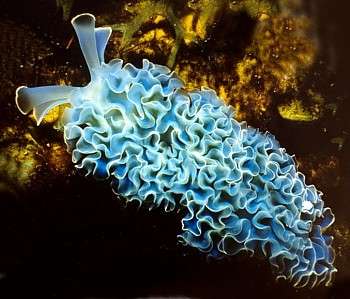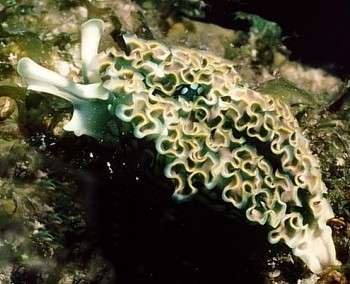

Elysia crispata
(Morch, 1863)
Order: SACOGLOSSA
Superfamily: ELYSIOIDEA
Family: Elysiidae
DISTRIBUTION
Caribbean
PHOTO
Upper right: Blue colour form - off Saba Island, Caribbean. Lower right:
LOWER RIGHT: Green colour form. Note dark green colouration caused by dense populations of symbiotic chloroplasts. Bahamas. Photos: Anne Dupont.
Large elysiid, up to 50 mm long and 30 mm wide with prominent parapodia which are very folded at the edge, with both primary and secondary semipermanent folds. The parapodia on each side fuse just in front of the pericardial hump, to form a barrier between the head and the pericardium. The green colour in E. crispata is much more localised in certain areas of the body than in E. clarki. The dorsal surface between the parapodia of well-fed E. crispata is generally green, interspersed with much larger white spots which, unlike those of E. clarki, often fuse together to form extended areas devoid of green . The head of E. crispata is usually only lightly pigmented with green, sometimes with a diffuse blue band extending between the rhinophores. The sides of the body, between the base of the parapodia and the foot are also green with large white spots in well-fed individuals. The outer edge of the parapodia often has a deep blue band of variable thickness. Along the parapodial edge there can be an orange band, sometimes tending to red. It may be continuous, intermittent or lacking entirely.
The foot is relatively thick, and muscular with distinct lateral edges. It is an opaque white with no green plastids visible in it or within the ventral part of the body covered by the foot. Specimens of E. crispata typically have a narrow blue pigment band running along the edge of the foot.
E. crispata has lecithotrophic larval development [non-feeding planktonic larvae] with veliger larvae metamorphosing into juvenile slugs after about 5 days. Unfortunately the food source for juveniles is unknown. The food of the adults is still problematic but they contain symbiotic plastids from Halimeda incrassata and Penicillus capitatus, but not from any other species of Halimeda or Penicillus, although other species of both genera are present in their natural habitats. The molecular studies indicate the presence of plastids from other algal species in E. crispata as well (Pierce et al, 2006).
Both E. crispata and E. clarki retain living chloroplasts which continue to photosynthesise within the body of the sea slug, providing it with sugars for its own nutrition. See the page on Solar powered sea slugs for further information. The process of taking chloroplasts from algal cells and keeping them has been given the name kleptoplasty
Until recently this species was placed in its own genus Tridachia because of the large folded parapodia, but Gosliner (1995) has argued that this is not only unnecessary, but confuses our understanding of the phylogenetic history of the family. It is better to consider it to be a species of Elysia with a very folded parapodial edge. Elysia crispata is very variable in colour. See photos of a red-lined variety.
Note: This species has been confused with Elysia clarki for many years. See separate message [#16728] comparing the two species. Many messages previously located with the E. crispata have been transferred to E. clarki.
-
Clark, K.B. & Busacca, M. (1978) Feeding specificity and chloroplast retention in four tropical ascoglossa, with a discussion of the extent of chloroplast symbiosis and the evolution of the order. Journal of Molluscan Studies, 44: 272-282, Figs 1-3.
-
Curtis, N. E., Massey, S. E., Schwartz, J. A., Tagihof, H. & Pierce, S. K. (2004) The intracellular, functional chloroplasts in adult Elysia crispata come from several algal species, and are different from those in juvenile slugs. Integrative and Comparative Biology, 44: 686.
-
Gosliner, T.M. (1995) The Genus Thuridilla (Opisthobranchia: Elysiidae) from the Tropical Indo-Pacific, with a Revision of the Phylogeny and Systematics of the Elysiidae. Proceedings of the Californian Academy of Sciences, 49(1):1-54.
-
Jensen, K. (1980) A review of sacoglossan diets, with comparative notes on radular and buccal anatomy. Malacological Review, 13: 55-77.
-
Pierce, S.K., Curtis, N.E., Massey, S.E., Bass, A.L., Karl, S.A. & Finney, C.M. (2006) A morphological and molecular comparison between Elysia crispata and a new species of kleptoplastic sacoglossan sea slug (Gastropoda: Opisthobranchia) from the Florida Keys, USA. Molluscan Research, 26(1): 23-38
-
Taylor, D. (1970) Photosynthesis of symbiotic chloroplasts in Tridachia crispata (Bergh). Comparative Biochemistry and Physiology, 38A: 233-236.
-
Trench, R.K. (1969) Chloroplasts as functional endosymbionts in the mollusc Tridachia crispata (Bergh). Nature, 222: 1071-1072.
ARCHIVE NOTE: An earlier edition of this Fact Sheet [6 December 1999] is available on request.
Authorship detailsRudman, W.B., 2006 (May 30) Elysia crispata (Morch, 1863). [In] Sea Slug Forum. Australian Museum, Sydney. Available from http://www.seaslugforum.net/factsheet/elyscris
Related messages
-
Lettuce slug behaviour
From: Bob Bailey, March 26, 2010 -
Two Elysia crispata from Saba, Windward Islands
From: Eric Kaye, March 26, 2010 -
Colour variations of Elysia crispata from Guadeloupe [2]
From: Hugues Flodrops, November 21, 2007 -
Colour variations of Elysia crispata from Guadeloupe [1]
From: Hugues Flodrops, November 21, 2007 -
Elysia with a ripped body
From: Patrick, October 4, 2007 -
Location of Elysia crispata - and other slugs?
From: Paul Jones, September 22, 2007 -
Elysia crispata? from Cuba
From: Simon Crawford, March 23, 2007 -
Re: Update on Elysia crispata feeding
From: Andrew Rodenbeck, August 30, 2006 -
Damaged Elysia crispata
From: D. Rose, August 28, 2006 -
Re: Update on Elysia crispata feeding
From: Colin Finney, May 6, 2005 -
Re: Update on Elysia crispata feeding
From: Skip Pierce, May 4, 2005 -
Re: Update on Elysia crispata feeding
From: Kathe R. Jensen, May 2, 2005 -
Re: Update on Elysia crispata feeding
From: Lindsey Holm, May 2, 2005 -
Elysia crispata - Here's a puzzle
From: Skip Pierce, January 4, 2005 -
Update on Elysia crispata feeding
From: Skip Pierce, August 6, 2004 -
Re: Elysia crispata feeding
From: Pszemol, July 16, 2004 -
Re: Elysia feeding
From: Skip Pierce, March 1, 2004 -
Re: Elysia feeding
From: Kathe R. Jensen, February 27, 2004 -
Elysia feeding
From: Skip Pierce, February 26, 2004 -
Elysia crispata - breeding in aquarium
From: Paul Baldassano, January 9, 2004 -
Elysia crispata from Jamaica
From: Ross W. Gundersen, October 10, 2003 -
Elysia crispata from Colombia
From: Ana Karina Yepes, October 1, 2003 -
Elysia crispata from Bonaire
From: Robert Fishman, September 11, 2003 -
Light color form of Elysia crispata
From: Linda Ianniello, July 21, 2003 -
Chloroplasts in Elysia crispata
From: Skip Pierce, June 30, 2003 -
More on Elysia crispata - feeding, DNA etc
From: Skip Pierce, May 8, 2003 -
Re: Elysia crispata and algal genes
From: Kathe R. Jensen, May 5, 2003 -
Elysia crispata research
From: Dirk Trauner , March 11, 2003 -
Elysia crispata toxicity..
From: Ken Woden, September 17, 2002 -
Re: Elysia crispata question...
From: Matt Galvin, December 18, 2001 -
Elysia crispata question...
From: Rich Hunziker , December 12, 2001 -
Re: Advice of keeping Elysia crispata in captivity
From: Kathe R. Jensen, October 9, 2001 -
Re: Elysia crispata
From: Anne DuPont, October 9, 2001 -
Chloroplasts in the 'lettuce leaf nudibranch'
From: Caroline Nelson, October 8, 2001 -
Re: Advice of keeping Elysia in captivity
From: Claude Poole, September 24, 2001 -
I need some Bryopsis
From: Kathleen Archer , September 21, 2001 -
Re: Advice of keeping Elysia in captivity
From: Kathe R. Jensen, September 17, 2001 -
Advice of keeping Elysia in captivity
From: Kathleen Archer , September 15, 2001 -
Elysia crispata from Colombia
From: Alexander Taborda Marin, June 16, 2001 -
Keeping Elysia crispata in aquaria
From: Alan Pittman, February 26, 2001 -
Elysia crispata in aquaria
From: Ryan, January 29, 2001 -
What is a Lettuce Nudibranch
From: Mike Dean, October 30, 2000 -
Elysia crispata v Tridachia crispata
From: Kathe R. Jensen, October 17, 2000 -
Re: Elysia crispata - egg coil
From: Kathe R. Jensen, October 15, 2000 -
Elysia crispata - egg coil
From: John Batson, October 6, 2000 -
Re: Lettuce Slug
From: Jonathan Laxton, August 3, 2000 -
What is a lettuce slug? help please......!
From: Jonathan LAxton, July 28, 2000 -
Elysia crispata & photosynthesis
From: Dave Behrens, December 10, 1999 -
Tridachia v Elysia crispata
From: David W. Behrens, December 7, 1999 -
Photos of the solar-powered 'Ruffled Sea Slug'
From: Anne DuPont, December 7, 1999 -
Red-lined form of Tridachia crispata
From: Anne Dupont, December 7, 1999
